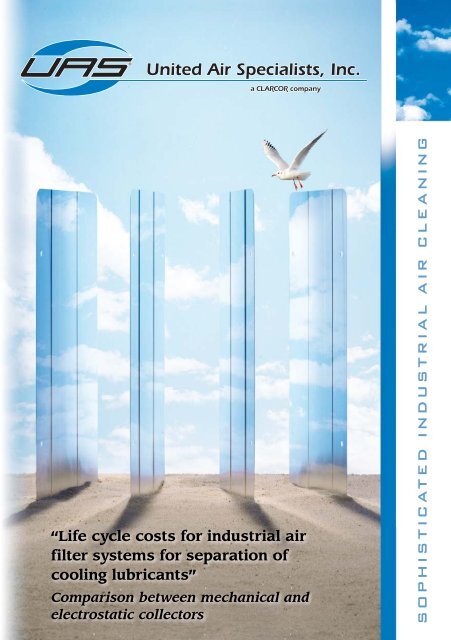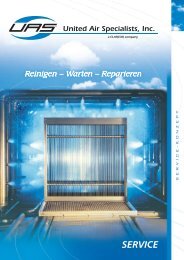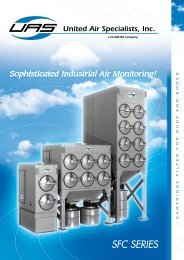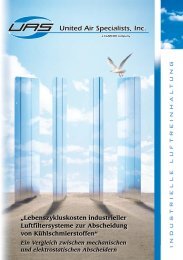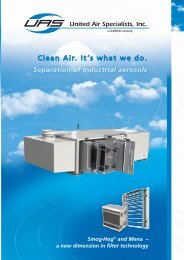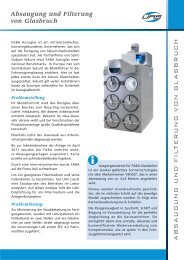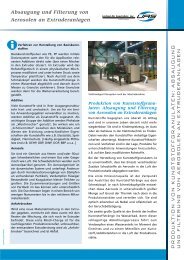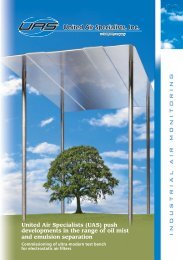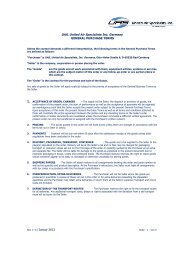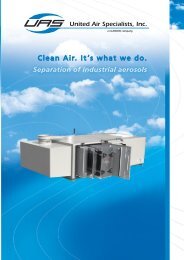Handbuch Umschlag.indd - UAS - United Air Specialists Inc.
Handbuch Umschlag.indd - UAS - United Air Specialists Inc.
Handbuch Umschlag.indd - UAS - United Air Specialists Inc.
Create successful ePaper yourself
Turn your PDF publications into a flip-book with our unique Google optimized e-Paper software.
“Life cycle costs for industrial air<br />
filter systems for separation of<br />
cooling lubricants”<br />
Comparison between mechanical and<br />
electrostatic collectors<br />
SOPHISTICATED INDUSTRIAL AIR CLEANING
„Life cycle costs for industrial air filter systems for separation of cooling lubricants“<br />
1. Print run 08-2008, translated from German language.<br />
Imprint<br />
Author: Carlo Saling, Produktmanager, <strong>UAS</strong> <strong>United</strong> <strong>Air</strong> <strong>Specialists</strong> <strong>Inc</strong>.<br />
Publisher:<br />
<strong>UAS</strong> <strong>United</strong> <strong>Air</strong> <strong>Specialists</strong> <strong>Inc</strong>., Branch office Germany<br />
Otto-Hahn-Str. 6 | 65520 Bad Camberg<br />
Phone +49 (0) 64 34 / 94 22-0 | Fax -99<br />
www.uas-inc.de<br />
Layout:<br />
IHW Jörn Jacobs & Co.<br />
Otto-Hahn-Str. 15 | 65520 Bad Camberg<br />
www.ihw-marketing.eu<br />
Reproduction – even in parts – with authorization of publisher, only.
„Life cycle costs for industrial air filter<br />
systems for separation of cooling lubricants<br />
Comparison between mechanical and electrostatic<br />
collectors“<br />
by Carlo Saling<br />
Globalisation as well as heavy<br />
growth of newly industrialising<br />
countries have led to considerable<br />
increase in competitive pressure<br />
on European industry in recent<br />
years. At the same time, this<br />
period has shown quite plainly<br />
that the era of “cheap” energy<br />
has passed. Given the shortage<br />
of resources, easing of resource<br />
costs – regardless whether for oil,<br />
natural gas, electricity, or industrial<br />
metals – is not foreseeable in<br />
the long run.<br />
In the years to come, energy<br />
efficiency will become an advantage<br />
in competition for business.<br />
Furthermore, we are obliged – no<br />
matter if as employee of a company<br />
or as person – to handle natural<br />
resources in a conscientious<br />
way.<br />
Life cycle costing provides an<br />
interesting approach. This considers<br />
the costs over the entire life<br />
cycle, i.e. starting with purchasing<br />
until final disposal. The VDMA<br />
(Verband Deutscher Maschinen-<br />
und Anlagenbau – association<br />
of German mechanical and<br />
plant engineering) has defined<br />
it as follows: Life cycle costs are<br />
the sum of all expenses required<br />
for use of a suitably designed<br />
machine or plant to the intended<br />
purpose, starting with purchasing<br />
until final disposal. [1]<br />
Particularly the operating expense<br />
for energy- and maintenance-intensive<br />
air filter systems<br />
is a multiple of the investment<br />
costs. Figure 1 shows the different<br />
cost types that may accrue from<br />
the moment of purchasing until<br />
disposal of a filter.<br />
Industrial air filter systems – also<br />
designated exhaust systems or<br />
filtering collectors – are designed<br />
to remove harmful and hazardous<br />
substances such as oil mist, emulsion<br />
mist, smoke, or dust from<br />
the ambient air of production –<br />
optionally directly on the machine<br />
or through a central shop exhaust<br />
system.<br />
Separation of cooling lubricants<br />
emitted as aerosol or vapour into<br />
the air as a consequence of metal<br />
machining in machine tools is an<br />
important field of application for<br />
industrial air filter systems. Cooling<br />
lubricants among others serve<br />
[1] VDMA – standard 34160<br />
1
Life cycle costs for industrial air filter systems for separation of cooling lubricants<br />
Life cycle costs<br />
Purchasing<br />
costs<br />
Operating<br />
costs<br />
Disposal<br />
costs<br />
Investment<br />
costs<br />
Energy<br />
costs<br />
Maintenance<br />
Disposal<br />
Planning<br />
Electricity<br />
Cleaning /<br />
Maintenance<br />
Dismounting<br />
Purchasing<br />
Heating /<br />
Cooling<br />
Repair<br />
Recovery /<br />
Disposal<br />
Installation<br />
Water<br />
Production<br />
downtimes<br />
Commiss. /<br />
Training<br />
Compressed<br />
air<br />
Figure1: Life cycle costs of an industrial air filter system<br />
cooling, lubricating, and rinsing of<br />
machined parts.<br />
The Ordinance on Hazardous<br />
Substances commits business to<br />
free the air inhaled by insurants<br />
from harmful substances (e.g.<br />
cooling lubricants). As a remedy<br />
for this issue air filter systems<br />
remove emissions directly from<br />
the ambient air. Fundamental<br />
principles of separation are:<br />
• Mechanical collectors<br />
• Electrostatic collectors (electrostatic<br />
filters)<br />
• Inertial collectors (centrifugal<br />
collectors)<br />
• Wet dust collectors (washers)<br />
This article will not deal with the<br />
fundamentals of such principles.<br />
Please refer to relevant literature<br />
and VDI guidelines (VDI 3677,<br />
VDI 3678, VDI 3676, VDI 3679).<br />
2
2% 6% 5%<br />
50%<br />
37%<br />
Mechanical collector<br />
Electrostatic collector<br />
Wet dust collector<br />
Centrifugal collector<br />
Other<br />
Figure 2: Conclusion of Metallberufsgenossenschaft (association of metal<br />
professions): Distribution of the filter systems actually used in companies<br />
This article considers the life<br />
cycle costs for mechanical and<br />
electrostatic collectors, only,<br />
because in the companies’ practise<br />
these collectors have a market<br />
share of 90% for exhaustion of<br />
cooling lubricants; see figure 2. [2]<br />
Classic centrifugal collectors are<br />
suitable to only a limited extent<br />
for modern machining processes<br />
because the principle of separation<br />
is based on forces of gravity.<br />
Since the largest share of particles<br />
emitted from machine tools<br />
is < 2 µm, gravity collectors should<br />
not be used as main filters.<br />
Measuring of BGIA has shown<br />
that the filtration efficiency in<br />
practise may even be negative due<br />
to a new emission of substances<br />
already separated. [3]<br />
In the companies’ practise, wet<br />
dust collectors are rarely used for<br />
separation of cooling lubricants.<br />
Wet dust collectors provide good<br />
separating performance; however,<br />
pressure loss of filters as well<br />
as water treatment lead to high<br />
operating expenses for the operating<br />
company. Wet dust collectors<br />
are an interesting alternative<br />
for use cases with high safety<br />
requirements (fire and explosion<br />
prevention) due to the process.<br />
[2] Source: BIA – Report 03/1991 “Kühlschmierstoffe<br />
– Umgang, Messen, Beurteilung,<br />
Schutzmaßnahmen” (Cooling lubricants<br />
– handling, measuring, safety measures)<br />
editor Berufsgenossenschaftliches Institut für<br />
Arbeitsschutz BGIA, St. Augustin, 1993<br />
[3] BGIA- Report 09/2006 “Absaugen<br />
und Abscheiden von Kühlschmierstoffen”<br />
(Exhaustion and separation of cooling lubricants)<br />
by W. Pfeiffer, editor Berufsgenossenschaftliches<br />
Institut für Arbeitsschutz BGIA,<br />
St. Augustin, 2006<br />
3
Life cycle costs for industrial air filter systems for separation of cooling lubricants<br />
Calculation of life cycle costs<br />
Cost types for procurement<br />
Investment costs are the largest<br />
share of procurement costs. The<br />
expenses for planning, installation,<br />
commissioning, and training<br />
can be neglected for a comparison<br />
of costs for mechanical and electrostatic<br />
filters, for those costs do<br />
not directly depend on the principle<br />
of filter. Costs for planning<br />
are equivalent for both principles<br />
of separation and many manufacturers<br />
of industrial filter systems<br />
provide the planner with advice.<br />
Costs for installation heavily<br />
depend on the space available on<br />
site. Costs for commissioning and<br />
training are comparable for both<br />
principles of separation, as well.<br />
In general the space required for<br />
a mechanical filter is larger than<br />
that required for an electrostatic<br />
filter.<br />
For this comparison, capital costs<br />
have been taken into consideration<br />
by discounting all costs with<br />
the respective cash value to time<br />
t 0<br />
. Tax advantages of investment<br />
costs that in contrast to operating<br />
costs are depreciable have been<br />
neglected for this consideration.<br />
Cost types during operation<br />
The operating expense for an<br />
industrial filter system for separation<br />
of cooling lubricants is<br />
primarily made up of expenses<br />
for electricity and maintenance.<br />
Normally, costs for water, cooling<br />
energy, heating energy,<br />
compressed air do not accrue.<br />
Energy costs considerably depend<br />
on the motor capacity of the fan.<br />
In mechanical filters, often high<br />
efficiency submicron particulate<br />
air filters (HEPA) are used as last<br />
filter stage designed to reach the<br />
requested filtration efficiency for<br />
submicron particles – particularly<br />
for recirculation air. Such deepbed<br />
filters provide the operating<br />
company with excellent filtration<br />
efficiency; however, since harmful<br />
substances remain in the filter<br />
stage, the flow resistance of<br />
the filter stages is continuously<br />
increasing during service life.<br />
As a consequence, pressure<br />
drops as well as power consumption<br />
of the fan increase as well.<br />
In the companies’ practise, the<br />
motor capacity of a mechanical<br />
filter is often more than twice the<br />
motor capacity of an electrostatic<br />
filter required to get comparable<br />
suction pressures. [4]<br />
[4] Suction pressure of a fan means that a<br />
comparable suction pressure is available for<br />
suction of harmful substances.<br />
4
Electrostatic filters provide the<br />
advantage that the flow resistance<br />
hardly increases over the<br />
operating time because the collector<br />
plates are arranged in parallel<br />
in flow direction allowing the<br />
harmful substances to run off the<br />
smooth surfaces. Another advantage<br />
is that most of the harmful<br />
substances are removed from the<br />
air flow, thus reducing the danger<br />
of evaporation compared to a<br />
filter fabric soaked with harmful<br />
substance.<br />
Maintenance expenses<br />
comprise the costs for spare filter<br />
or cleaning of the filter elements,<br />
respectively. The filter elements<br />
of mechanical filter systems (e.g.<br />
non-woven, fabric) have to be<br />
replaced when the fabric is saturated<br />
with harmful substances and<br />
the filter – due to an increased<br />
flow resistance – fails to suck the<br />
harmful substances.<br />
Then, filter elements have to be<br />
disposed of as hazardous waste.<br />
The expenses for disposal have<br />
been neglected for this consideration.<br />
Only the expenses for spare<br />
parts as well as for one man-hour<br />
required for replacing a filter<br />
element have been considered.<br />
Electrostatic filter elements<br />
(pre-filters, ionisers, and collectors<br />
of metal) can be cleaned in<br />
an ecologically minded way in<br />
ultrasonic cleaning devices and be<br />
reused subsequently. The calculation<br />
assumes that the customer<br />
will replace the filter elements<br />
autonomously. Actually, companies<br />
often proceed this way in<br />
case of single filters. For a troublefree<br />
operation, you only shall have<br />
a spare part set of filter elements<br />
in stock. Soiled filter elements can<br />
be taken out of the filter easily via<br />
guide rails and e.g. sent to <strong>United</strong><br />
<strong>Air</strong> <strong>Specialists</strong> <strong>Inc</strong>. for central<br />
regeneration in an ultrasonic<br />
cleaning device. <strong>UAS</strong> offers all new<br />
customers a free of charge training<br />
on this subject. Subsequently,<br />
the cleaned filter elements will<br />
be sent back to the customer for<br />
reuse. The calculation of costs<br />
includes one customer manhour<br />
required for replacing of a<br />
filter element. Cleaning expenses<br />
(external) for the filter elements<br />
as well as disposal costs for cleaning<br />
agents have been considered<br />
in the calculation. If a company<br />
has a large number of filters, the<br />
cost-effective service by <strong>UAS</strong> or its<br />
service partners in a comprehensive<br />
network is reasonable.<br />
Furthermore, the calculation<br />
includes expenses for wear and<br />
tear amounting to 3% p.a. for<br />
both separation principles.<br />
5
Life cycle costs for industrial air filter systems for separation of cooling lubricants<br />
Cost types for disposal<br />
Disposal costs comprise dismounting<br />
of the system as well<br />
as disposal of the material. Since<br />
the expenses for both separation<br />
types are similar, we have<br />
neglected such expenses or used<br />
identical values, respectively.<br />
Calculation of life cycle<br />
costs<br />
We have taken an example (air<br />
flow 2,000 m³/h) for calculation<br />
of the life cycle costs of industrial<br />
filter systems for separation<br />
of cooling lubricants. We have<br />
considered different cost scenarios<br />
to get a representative view.<br />
Assumptions for calculation<br />
Parameters Mechanical filter Electrostatic filter<br />
Scenarios Minimum Maximum Minimum Maximum<br />
Number of filters 1 piece 1 piece<br />
List price 2,500 € 5,500 € 3,500 € 7,000 €<br />
Costs: commissioning / training 600 € 600 €<br />
2 3 2 3<br />
Number of filter stages<br />
Pre-filter, main filter,<br />
possibly HEPA<br />
Pre-filter, 1 - 2 main<br />
filter(s) (collectors)<br />
Operating time 8.000 h per year 8.000 h per year<br />
Pressure loss of filter 250 Pa 800 Pa 120 Pa 200 Pa<br />
Suction pressure 350-450 Pa 350-450 Pa<br />
Motor capacity 1.5 kW 2.2 kW 0.75 kW 0.85 kW<br />
ø–load intake 60% 60%<br />
<strong>Air</strong> recirculation Yes Yes<br />
Ø-service life 3,000 h 9,000 h 1,500 h 2,500 h<br />
Maintenance<br />
Ø-costs per spare filter element<br />
200 € 350 € – –<br />
Maintenance; Ø-costs for cleaning of<br />
all filter elements<br />
– – 70 € 90 €<br />
Costs for working time 45 € per hour 45 € per hour<br />
Expenditure of human labour for<br />
replacing of a filter element<br />
1 hour 1 hour<br />
Electricity tariff Cents/kWh 10 Cent 15 Cent 10 Cent 15 Cent<br />
Capital costs, interest rate 5% 5%<br />
Wear and tear 3% per year 3% per year<br />
Operating life 10 years 10 years<br />
Disposal costs for filter and material 1,250 € 1,250 €<br />
Figure 3: Single-position exhaustion of cooling lubricants (air flow: 2,000 m³/h)<br />
6
Calculation results [5] Mechanical Electrostatic<br />
Supplier<br />
Example<br />
Minimum [5]<br />
<strong>United</strong> <strong>Air</strong><br />
<strong>Specialists</strong><br />
Manufacturer’s type Example SH Modular<br />
General expense Minimum [5] Maximum<br />
Maximum<br />
Number of filters<br />
1 unit<br />
Investment costs [€]<br />
Purchase price per filter 2,500.- 5,500.- 3,500.- 7,000.-<br />
Piping and fittings 0.- 0.- 0.- 0.-<br />
Installation 0.- 0.- 0.- 0.-<br />
Commissioning 500.- 500.- 500.- 500.-<br />
Training 100.- 100.- 100.- 100.-<br />
Others 0.- 0.- 0.- 0.-<br />
Total [€] 3,100.- 6,100.- 4,100.- 7,600.-<br />
Operating costs [€]<br />
Electricity costs 720.- 1.584.- 360.- 612.-<br />
Maintenance costs 471.- 3.085.- 473.- 930.-<br />
Total [€] 1,.191.- 4.669.- 833.- 1.542.-<br />
Disposal costs [€]<br />
Disassembly 1,000.- 1,000.- 1,000.- 1,000.-<br />
Disposal 250.- 250.- 250.- 250.-<br />
Other costs 0.- 0.- 0.- 0.-<br />
Total [€] 1,250.- 1,250.- 1,250.- 1,250.-<br />
CO 2<br />
emission in tons per year [6] 4.3 6.3 2.2 2.4<br />
Figure 4: Table with results<br />
[5] Calculation of min. costs with min. investment costs, min. number of filter elements, min. motor capacity<br />
of fan, min. electrical costs, min. spare parts costs or min. cleaning costs, respectively, and longest<br />
service life<br />
[6] Based on motor capacity of fan<br />
7
Life cycle costs for industrial air filter systems for separation of cooling lubricants<br />
Results<br />
Normally, the list price for an<br />
electrostatic collector is above the<br />
price for a mechanical collector.<br />
Since the prices depend heavily on<br />
the number of filter stages as well<br />
as on optional features, we have<br />
defined a wide range of costs for<br />
both filter systems covering the<br />
spectrum of market prices.<br />
Investment costs for a mechanical<br />
filter range between 2,500 and<br />
5,500 € for an operational volumetric<br />
flow range [7] of 2,000 m³/h,<br />
whereas electrostatic collectors<br />
range between 3,500 and 7,000 €.<br />
This difference induces many<br />
companies to opt for an investment<br />
in mechanical filter systems.<br />
For commissioning and training,<br />
we have assessed expenses<br />
amounting each to 600 € per day.<br />
A view on the operating costs<br />
shows different results. The motor<br />
capacity of the mechanical example<br />
representing the experiences<br />
gained in companies’ practise<br />
corresponds to 1.5 – 2.2 kW. The<br />
motor capacity of an electrostatic<br />
collector amounts to only 750 –<br />
850 W. Both filter systems of the<br />
example provide a suction pressure<br />
of about 350 – 450 Pa. Whilst<br />
power consumption of a fan in<br />
electrostatic collectors is comparatively<br />
constant, power consumption<br />
of the fans in mechanical<br />
filters heavily depends on the load<br />
of harmful substances in the<br />
[7] Do not mistake the operational volumetric<br />
flow rate for the idling capacity of the fan!<br />
individual filter elements. In the<br />
beginning, pressure loss ranges<br />
from about 250 to 300 Pa, however,<br />
it may increase up to 800 Pa<br />
during operation when the filter<br />
elements are saturated with harmful<br />
substances.<br />
Should the crude gas load on<br />
the filter inlet be high, doublestage<br />
electrostatic filters with<br />
mist eliminators are a suitable<br />
solution. The double-stage solution<br />
is of advantage because it<br />
increases the filter service life<br />
and the separating performance<br />
during short-term flashovers,<br />
which might occur in case of cooling<br />
lubricants with a high proportion<br />
of water, will not be affected<br />
considerably. Such flashovers are<br />
popular reason to opt against<br />
electrostatic filters; however, such<br />
flashovers can almost be excluded<br />
by clever monitoring of the highvoltage<br />
range as well as selective<br />
design modifications. Only pressure<br />
sensors of sufficient accuracy<br />
may detect filter fractures and<br />
defective spots in the fabric of a<br />
mechanical collector.<br />
In both cases, power consumption<br />
(load) of the fans averages<br />
to 60%. Based upon these data<br />
and upon an assumed electricity<br />
tariff of 10 – 15 Cents per kWh<br />
(VAT excluded), the electricity<br />
costs for mechanical filters are 720<br />
– 1,584 € (7,200 – 10,500 kWh)<br />
per filter and for an electrostatic<br />
collector 360 – 612 € (3,600<br />
– 4,800 kWh). Apart from the<br />
economic point of view, such<br />
8
economy of electricity of about<br />
50% corresponds to a CO 2<br />
equivalent<br />
[8] of at least 2 t CO 2<br />
per year<br />
emitted less into the atmosphere.<br />
Maintenance costs (servicing<br />
and cleaning) for the mechanical<br />
filter have been limited to<br />
replacing of filter elements. We<br />
have assumed one man-hour for<br />
replacing of one filter element<br />
(in-company hourly rate: 45 €).<br />
The top reference value for the<br />
service life of a mechanical filter<br />
is based on specifications made<br />
by a competitor who assures<br />
his customers of a service life<br />
of up to 9,000 h for a mechanical<br />
filter element. An operating<br />
time of 8,000 h per year would<br />
result in less than 1 exchange per<br />
year. Usual prices on the market<br />
for spare filter elements are 200 -<br />
350 € per element. Disposal costs<br />
for mechanical filter elements<br />
saturated with cooling lubricant<br />
(hazardous substance) have not<br />
been taken into consideration for<br />
this calculation.<br />
The service life of an electrostatic<br />
filter element has been specified<br />
with 1,500 – 2,500 h. This assumption<br />
is based on the experiences<br />
gained by the services of <strong>United</strong><br />
<strong>Air</strong> <strong>Specialists</strong> <strong>Inc</strong>. and represents<br />
a conservative approach. For<br />
replacing of filter elements, we<br />
have again considered one manhour<br />
per exchange. The filter<br />
elements of the electrostatic filter<br />
(pre-filters, ionisers, collectors)<br />
can be cleaned and reused, e.g.<br />
in the ultrasonic cleaning systems<br />
of <strong>UAS</strong>. Disposal of filter elements<br />
is not required. Cleaning of filter<br />
elements is normally charged with<br />
70 – 90 €.<br />
Therefore, maintenance costs<br />
for a mechanical filter amount to<br />
471 – 3,085 € and those for an<br />
electrostatic filter to 473 – 930 €<br />
(each incl. 3% for wear and tear<br />
per year). Below the line, the<br />
maintenance costs for an electrostatic<br />
filter will usually be<br />
less, despite the assumption of a<br />
multiple service life of mechanical<br />
filters.<br />
In total, the operating expenses<br />
for a mechanical filter range<br />
between 1,191 and 4,699 €,<br />
whereas the running expenses<br />
for an electrostatic collector only<br />
range between 833 and 1,542 €<br />
per year.<br />
Disposal costs for both collectors<br />
have been set to 1,250 €. Just<br />
as the costs for installation, such<br />
costs heavily depend on the space<br />
available on site.<br />
[8] Information by ifeu (Institut für Energieund<br />
Umweltforschung Heidelberg – Institute<br />
for Energy and Environmental Research in<br />
Heidelberg, Germany) on a CO 2<br />
equivalent<br />
of the German electricity mix of 0.6 kg per<br />
kWh, survey on behalf of Federal Environmental<br />
Agency.<br />
9
Life cycle costs for industrial air filter systems for separation of cooling lubricants<br />
Conclusion<br />
The calculation example compares<br />
life cycle costs for mechanical<br />
and electrostatic air filter<br />
systems of a suction capacity<br />
of 2,000 m³/h. The calculations<br />
consider different scenarios (minimum<br />
and maximum) concerning<br />
investment costs, service life of<br />
filter elements, number of filter<br />
stages and their maintenance<br />
costs, as well as electricity costs.<br />
Adding and discounting investment,<br />
operating, and disposal<br />
costs leads to figure 5.<br />
This figure impressively proves<br />
that opting for an investment in<br />
electrostatic collectors in many<br />
cases is advantageous. Despite<br />
the higher investment costs, electrostatic<br />
collectors will break even<br />
after a short time of operation<br />
already.<br />
In order to approach reality, we<br />
have taken different scenarios<br />
into consideration.<br />
It is important to discount capital<br />
costs – here assumed with 5%<br />
– over the procurement period<br />
to take into account the higher<br />
purchasing costs for electrostatic<br />
filters.<br />
accumulated cash values in [€]<br />
45.000 €<br />
40.000 €<br />
35.000 €<br />
30.000 €<br />
25.000 €<br />
20.000 €<br />
15.000 €<br />
10.000 €<br />
5.000 €<br />
Cost comparison with cash method<br />
0 €<br />
0 Years 2 Years 4 Years 6 Years 8 Years 10 Years 12 Years<br />
mechanical filter minimum and maximum<br />
max.<br />
max.<br />
min.<br />
min.<br />
electrostatic filter minimum and maximum<br />
Figure 5:<br />
Comparison of life cycle costs between mechanical and electrostatic collectors<br />
10
After an operation of 10 years,<br />
cost differentials of up to 25,000 €<br />
per filter will result – without<br />
impairment of air quality. On the<br />
contrary: The economy of electricity<br />
will reduce CO 2<br />
emissions by at<br />
least 2 tons CO 2<br />
per year.<br />
The example shows that a<br />
comparison of life cycle costs<br />
as basis for decision-making of<br />
companies pays off and at the<br />
same time preserves resources.<br />
Less investment costs for mechanical<br />
collector systems seem to be<br />
more favourable on the surface,<br />
only.<br />
This example is even based on a<br />
multiple service life of mechanical<br />
filters compared to electrostatic<br />
filters.<br />
Furthermore, the filter elements<br />
of the electrostatic filter can be<br />
cleaned in an ecologically minded<br />
way to be reused subsequently.<br />
No hazardous waste result!<br />
Disposal costs have not been<br />
considered in the calculation.<br />
The difference in life cycle costs<br />
in case of higher volume flow even<br />
increases. This is the reason why<br />
power station technology prefers<br />
electrostatic filters with low pressure<br />
loss for air purification.<br />
The results show: A comparison<br />
of costs is profitable!<br />
Seemingly less expensive may<br />
become expensive for companies!<br />
Revision: 0808<br />
11
12<br />
Life cycle costs for industrial air filter systems for separation of cooling lubricants
Branch office Germany:<br />
Otto-Hahn-Str. 6 | 65520 Bad Camberg<br />
Phone +49 (0) 64 34 / 94 22-0 | Fax -99 | info@uas-inc.de | www.uas-inc.de<br />
Office North:<br />
Neuenlander Straße 5 | 27299 Langwedel<br />
Phone +49 (0) 42 35 / 9 29 94 | Fax 9 29 96<br />
Office Nordrhein-Westfalen:<br />
Auf dem Eigen 2 | 42349 Wuppertal<br />
Phone +49 (0) 2 02 / 2 47 81 40 | Fax 2 47 81 66<br />
Office Central:<br />
Dehrner Straße 12a | 65554 Limburg<br />
Phone +49 (0) 64 33 / 70 06 36 | Fax 81 33 3<br />
Office Sachsen:<br />
Daubaer Straße 20 | 01847 Lohmen<br />
Phone +49 (0) 35 01 / 58 83 44 | Fax 58 81 97<br />
Office Baden-Württemberg / Bayern:<br />
Büchel GmbH | Breite Str. 27 | 89168 Niederstotzingen<br />
Tel. +49 (0) 73 25 / 96 05 0 | Fax 96 05 80<br />
Office Austria:<br />
Hallestraße 29 | 4030 Linz | Phone +43 (0)7 32 / 31 38 13 | Fax 30 44 89


